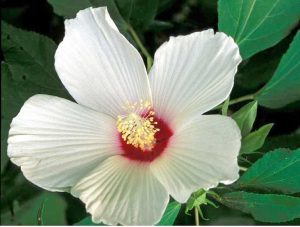Rose-Mallow August 2019 Wildflower of the Month
by Helen Hamilton, John Clayton Chapter
The wide showy flowers of Rose-Mallow signal the start of summer, as they bloom profusely in moist areas until September. Each flower is open for only a day, but they follow sequentially over time. The bloom is a larger version of okra, cotton or hollyhocks which are also members of the mallow family. The flowers are usually white or pink, but may be a pale yellow. All have a red or maroon center and a projecting column of stamens. Many cultivars are available at nurseries, with color variations.
“Hibiscus” is the Greek name for mallow, and “moscheutos” means “scented like the musk rose”. Many of the hibiscus are called “marshmallow” because of their family relationship to Althaea officinalis, a plant introduced from Europe from which marshmallows were made (now produced from corn syrup and gelatin).
In folk medicine, a poultice of the leaves and roots was used on breast tumors and for gastrointestinal, lung, and bladder problems, as it produces a locally soothing effect.
Rose-mallow grows in all regions of Virginia, and is found in the coastal plain. The plant prefers full sun, and moist to average soil, but will tolerate clay soil. Propagation by seed is easiest, as division requires a cleaver or machete and a person with a strong back.
Many species of butterflies and hummingbirds seek nectar from hibiscus. Rose-mallow is deer resistant.
For more information on native plants visit the state website: https://vnps.org

